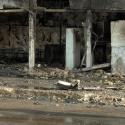 |
 |
The Islamic State of Iraq and the 'Destroying the Walls' Campaign
Sep 21, 2012 - Sam Wyer


Since the withdrawal of U.S. Forces from Iraq in December 2011, the rate and lethality of attacks against civilian targets have steadily risen. Most notably, there have been seven major attack waves, defined here as a series of simultaneous and coordinated attacks that target at least 10 cities within one day.2 The attacks targeted a combination of security posts, government facilities, and Shi’ite shrines and neighborhoods. The Islamic State of Iraq (ISI), an umbrella organization formed in 2006 for many Sunni insurgency groups including al-Qaeda in Iraq (AQI), has claimed credit for a large majority of these attacks.3 This summer has seen a further alarming development with the announcement of ISI’s “Destroying the Walls” campaign.
On July 21, 2012, Abu Bakr al-Baghdadi, the leader of ISI, announced the start of the “Destroying the Walls” campaign in his first online statement since he took control of ISI in 2010. Al-Baghdadi stressed the “start of a new phase of jihad” in Iraq in a rallying cry to “refuel” the battle with additional Sunni supporters.5 Two days later, a massive wave of attacks struck over 20 Iraqi cities and left more than 115 dead. These attacks marked the beginning of a new era of coordinated attack waves orchestrated by ISI throughout Iraq. The three major attack waves executed since start of the “Destroying the Walls” campaign outmatch previous waves in terms of overall causalities, attack intervals, and geographic range.
Destroying the Walls
In recent statements, ISI outlined two main priorities for the new campaign: First, to secure “releasing of Muslim captives everywhere” and second, to “dominate the territory” that was previously controlled by ISI in 2006. To accomplish these objectives, ISI launched a campaign to target “the operational joints of the Safavids,” a reference to Maliki’s Shi’a-dominated government. They called for the targeting of the “staff, followers, and supporters” of Maliki’s rule, to include state “judges and interrogators” as well as other Shi’ite government officials, and the Iraqi security apparatus. In effect, however, ISI’s “Destroying the Walls” campaign has consistently targeted Shi’ite civilians along with security posts and other government targets.
The “Destroying the Walls” campaign indicates the degree to which ISI has grown in its ability to plan, coordinate, and execute attacks since the withdrawal of U.S. forces. The three major attack waves since the beginning of the campaign have occurred at a regular 24 day interval, which is a significant rate increase as compared to the previous four attack waves in 2012 that were separated on average by 37 days. Furthermore, the newest attack wave expanded geographically from Mosul to Basra. The September 9 bombings were particularly significant as the first ISI attacks to strike the predominately Shi’a areas of southern Iraq since the ISI suicide bombings in Nasiriyah and Basra in January 2012. Furthermore, the September 9 attack wave demonstrates a nation-wide command and control capability to synchronize attacks from Mosul and Kirkuk in the north to Basra in the south.